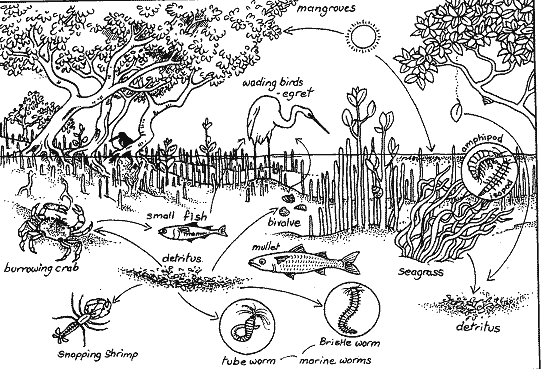|
Challenging Habitats: Southern Saltmarshes
and Mangroves
The information presented here has been written by staff at the
Marine Discovery Centre, Queenscliff, Victoria.
3. Ecology Closeup: Mangrove Food Cycle |
|

Mangrove Food Web: This Illustration is from A.B. Sea - A Cross-Curricula Guide to Marine Studies by Nancy Tsernjavski
In mangrove communities sunlight energy is trapped by the mangrove trees through the process of photosynthesis. Leaves falling from the trees into the water are attacked by many bacteria and other microbes that break the leaves down into particles of organic material. This material represents a major food source for other animals living in the mangrove community and is referred to as detritus.
There are a large number of species that feed directly on detritus. Worms in the sediment take in large amounts of sediment and digest the detritus for their own needs. Crabs and shrimp also consume large quantities of the detritus sift through the sediment to get their requirements. Filter feeding animals that live attached to the mangrove trunks or pneumatophores such as barnacles and mussels also can use the detritus in the water as an energy source. Some fish like mullet also feed on organic material in the water.
In turn these animals become food for other larger animals. Wader birds such as egrets feeding on the
exposed mudflats will seek out shrimp and crabs. Other birds with suitable beaks such as spoonbills or ibis will dig down deep into the mud looking for worms. Filer feeding molluscs like mussels and pippies become food for birds like oystercatchers that have strong beaks for breaking through shells. Larger fish move under the mangroves when the tide comes in looking for invertebrates like the crabs or shrimp, as well as eating smaller fish.
Mangroves are also important because they trap silt washing down rivers and prevent it from reaching and covering over rocky reefs or seagrass beds. They also protect the banks of estuaries from erosion caused by the wake from boats moving through the water by absorbing the energy from the waves.
Next - Habitat Issues / Threats |